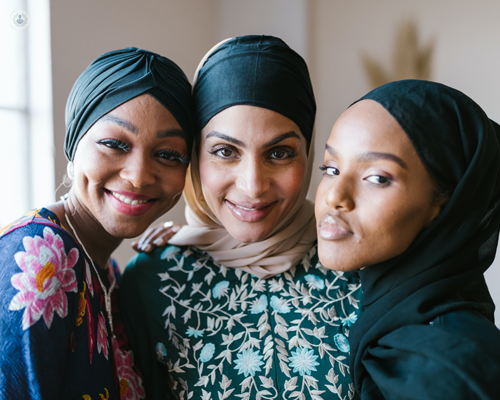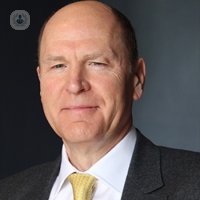Family history of breast cancer: When should I see a specialist?
Autore:You may wonder exactly when family history of breast cancer leads to specialist attention. For example, if your cousin has breast cancer, should you arrange an appointment?
Leading oncoplastic breast surgeon Professor Andrew Baildam provides an in-depth take on exactly when further investigation, like gene testing, is required in this informative and comprehensive article. He also goes into expert detail about managing risk of developing breast cancer, how risk is measured and warning signs of breast cancer.

Why do some people carry an inherited risk of breast cancer? How common is this?
There are specific genes that are acting in our bodies all the time, to prevent rogue cells from developing and becoming outside the body's own immune system. Some of the genes get switched off or get altered, so we talk about them as being gene mutations but actually they're just gene variants. The body loses its control of abnormal cells.
Now, some of these have been named and identified. There's the BRCA-1, BRCA-2. There are others as well like CDH, PALB2 and TP53. If a person, for example, is in a family that carries one of these genes, they have a chance of inheriting it. If a person's parent has a BRCA-1 or BRCA-2, they have a 50 per cent chance of having inherited that.
Now, it's hard to know exactly how common this is. There are certain populations who harbour a particular type of gene variant. For example, there's a BRCA-2 variant in Iceland which is particular to that population of 300,000 people. There are BRCA variants in Ashkenazi Jewish heritage, and probably three to five per cent of those actually carry the gene variant.
It's impossible to say how common these are over a general population but they can be focussed on individual populations.
When should you see a specialist about a family history of breast cancer?
Firstly, breast cancer is really common. About one in 9 women in the UK will develop breast cancer. A lot of that will be at an old age, but some of that will be at young age. And that is particularly the age group in which these gene variants act. In people under the age of 40 who are diagnosed with breast cancer, there's a significant change that it might be related to a gene variant.
My advice about a family history is: 'If you have first degree relative who has been affected with breast cancer, and that means a mother, a sister and a daughter.' Second degree relatives, you can get advice but that's much less likely to be impacting directly upon you, unless something develops in the history.
Anyone with a first-degree relative who's had breast cancer, should get some advice and go to your GP, see what the GP thinks and if the risk is going to be sufficiently high when it's calculated. So, for example, someone who has a mother who's had bilateral breast cancer (both breasts) then that risk is going to be higher than if it was just on one side, a GP will refer you on to a family history service.
How is a person’s risk measured?
The first thing is to:
- Look at the person's age;
- Look at the number of relatives who've had breast cancer, or ovarian cancer;
- Look at the ages which they were diagnosed - if an elderly relative got breast cancer in their eighties, that probably doesn't have much impact on your own risk but if a relative got a breast cancer, a sister, for example in their thirties, that significantly raises your risk.
It can all be calculated. There's a very carefully-researched equation; a way of calculating a person's risk called the Tyrer-Cuzick Model. It takes into consideration, not just the relatives, but:
- The age of the person;
- Their body morphology;
- Whether or not they've taken oestrogen-based medications at some time in their lives;
- How many children they've had;
- How old they were at their first pregnancy.
All those things are calculated within it.
That's the best way of calculating an individual's risk and if someone is found to carry a gene variant; if there's one in the family, if you do gene testing and they do have one of these BRCA-1 or BRCA-2 variants, their personal risk is going to be extremely high. It's going to be around 80 per cent. In the absence of a definite gene variant, then, the risk can be calculated statistically. Generally, anything over 25 to 30 per cent is considered high risk.
How is an elevated risk of breast cancer managed across a person’s lifetime?
An elevated risk can be used up as years go by. For example, if a person at the age of 30 has a calculated risk of 35 per cent over their lifetime, by the time that person gets to old age where they're in their seventies or eighties, they've used up most of that risk if they haven't had breast cancer. We usually calculate it what percentage risk of a year, what the percentage risk of ten years is and we can also relate it back to the background population risk. So, what is the risk ratio compared to the background population.
As time goes by, risk becomes less. A person in their eighties who had a 30 per cent risk at 40, doesn't still have a 30 per cent risk. They don't take that risk with them right to the last year. It still means that in the next year, they'll have several percentage points of risk.
In terms of managing breast cancer risk, the family history clinics and the genetics services can give a calculation of how high a risk a person is, and then according to that, they can categorise into low risk, moderate risk, high risk, and very high risk. They can advise and offer a surveillance programme. They may say 'look, your risk is the background population, just be breast aware, have your mammograms and if you find anything in the breast, let your doctor know and get help.'
If it's moderate risk or high risk they'll offer annual screening and in a young age that will often be with mammograms and magnetic resonance imaging scans, often alternated every couple of years. At an older age, they may just do it with mammography. There will definitely be an increased programme of surveillance offered to those with a higher risk.
Other than a family history, which factors make a person more likely to suffer from breast cancer?
The other factors that we know are important are weight. So, body mass index; people who have a higher BMI have a statistically higher risk of being diagnosed with breast cancer compared to those who aren't with a high BMI.
Exercise is a benefit; people who exercise regularly have a lower chance. People who have children and who have breast fed those children have a lesser chance than those who haven't. And the other thing that matters is the age of first pregnancy. Pregnancy at a young age, in the twenties seems to protect more than a pregnancy later on. Other factors are alcohol and use of HRT, hormone replacement therapy. That's statistically, if taken for five years increases a risk of breast cancer.
What are the warning signs of breast cancer?
The most important thing is that a woman is breast aware and knows her own breast than anyone else; certainly, better than her GP or better than the practice nurse. So, a person who checks their breasts, no more than once a month, but if they're just aware of how their breasts look and feel:
- If there's a thickening or a lump, that's something that needs looking at;
- If there's discharge from the nipple, particularly if the nipple is giving a blood-stained fluid that comes out;
- If they notice that the nipple is distorting - maybe the nipple is pulling in and it hasn't done that before;
- Maybe the breast has a little dimple or a shadow.
All these things are important. A woman who is breast aware will:
- Look at their breasts in the mirror, look for symmetry, look for any changes in shape;
- Raise their arms above themselves to see if that makes a difference - very gently, with the opposite hand, feel each breast in turn;
- Don't forget to feel behind the nipple as well as the bit up under the arm where often there's excessive breast tissue.
Sometimes in the bathroom or the shower, that's the easiest place to do it because a soapy hand can find changes in the breast more easily. If there's something that has changed, let your doctor know, go to your GP and make an appointment. Get a clinical examination and if necessary, get a referral to the breast clinic.
If you’re concerned about a family history of breast cancer or require expert oncoplastic breast surgery, arrange an appointment with this Greater Manchester, Wilmslow and London breast cancer expert via his Top Doctors profile.


